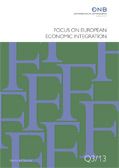Focus on European Economic Integration Q1/23
 OeNB
OeNB
- Erschienen:
- Februar 2023
 OeNB
OeNB
Saving behavior along the income distribution during the COVID-19 pandemic (PDF, 800 kB) Ellmeier, Koch, Scheiber. Aggregate data suggest that in several middle- and high-income countries, household savings increased during the first phase of the pandemic. Statistics from countries in Central, Eastern and Southeastern Europe (CESEE) also point in this direction. However, data and research on how this increase in savings is distributed along the income distribution are scarce. We provide evidence for eight CESEE countries, evaluating data from the OeNB Euro Survey wave 2021 on that matter. More precisely, we focus on how saving behavior of individuals differs across income and education groups. We find that, in general, people with higher levels of income and education have higher saving abilities – this is true before and during the pandemic. However, overall, only very few individuals have increased their saving since the start of the pandemic. When asked about saving intentions after the pandemic, particularly individuals from the highest income tercile say that they expect to increase their saving in the future. The combined evidence of aggregate and survey data points to a high degree of saving inequality across the population in all countries. en household saving, inequality, survey data, CESEE D14, D31, G51 20.02.2023, 00:00:00
Russia’s banking sector and its EU-owned significant banks, against the backdrop of war and sanctions (PDF, 432 kB) Barisitz, Deswel. Russia’s invasion of Ukraine in February 2022 and unprecedented waves of Western sanctions have worsened the overall economic environment for the Russian banking system and European banks that are active in the country. The suspension of the publication of key prudential indicators by the Bank of Russia (CBR) since the outbreak of the war has also rendered an analysis of most recent banking developments much more difficult. After initial sanctions-triggered instability in March 2022, the authorities managed to re-establish some fragile macroeconomic and financial stability later in spring. Nevertheless, Russia is moving from a resilient post-COVID recovery to a pronounced recession in 2022 and the economy will likely bottom out in 2023. The banking sector, dominated by a few large state-owned players, has gone from driving growth through lending expansion to being affected by the downturn and supported by credit subsidy programs. The largest Russian banks (including Sberbank) have been sanctioned and barred from SWIFT (market share of these banks: almost two-thirds of total sector assets). Due to sanctions and the downswing, the banking sector made a loss of about USD 25 billion in the first half of 2022 (around 12% of its registered capital or more than a fifth of its additional capital buffers at end-2021), the sector’s first loss in seven years. Although Western jurisdictions froze about half of Russia’s sizable international reserves in February, the authorities have continued to benefit in recent months from substantial revenue inflows due to very high energy prices. The CBR and the government currently appear prepared to support the economy and banks through 2022 and probably 2023, even in the likely event that banks lose a much larger share of their capital due to the unfolding crisis. In this context, the European banks that qualify as significant institutions (Raiffeisenbank Russia, Rosbank/Société Générale and UniCredit Bank Russia) have been fundamentally revising their strategies and activities. The war in Ukraine and Western sanctions have strongly increased the level of risk of their activities and led them to initiate various disengagement strategies (ranging from full exit to a material reduction of operations). Their provisioning levels have noticeably increased, especially with respect to credit risk in a situation where the risk outlook has materially deteriorated for a wide range of counterparties. Emerging risk factors like cyber risk, exchange rate risk (with the complexity of hedging strategies), market risk (given increased volatility and funding costs) and noncompliance risk with the latest sanctions regime have required enhanced monitoring. Reputational risk appears as a key risk factor. Available projections show a capacity for European banks to resist further shocks. They are also accumulating capital in light of the resilient war-time profitability they have shown so far and their incapacity to distribute dividends abroad. Yet Russia’s war in Ukraine represents a paradigm shift given the large share of previously identified threats (in the pre-war period) that materialized in swift succession. en banking sector, European banks, Russia, financial stability, sanctions, COVID-19, crisis, crisis-response measures, credit risk, nonperforming loans, profitability, regulatory forbearance, shock-absorbing factors G21, G28, P34 20.02.2023, 00:00:00
27th Global Economy Lecture: Sergei Guriev on “The political economy of Putin’s war in Ukraine” (PDF, 99 kB) en 20.02.2023, 00:00:00
Conference on European Economic Integration 2022: Economic and monetary policy under wartime conditions – implications for CESEE (PDF, 185 kB) en 20.02.2023, 00:00:00
Referees for Focus on European Economic Integration 2020−2022 (PDF, 102 kB) en 20.02.2023, 00:00:00